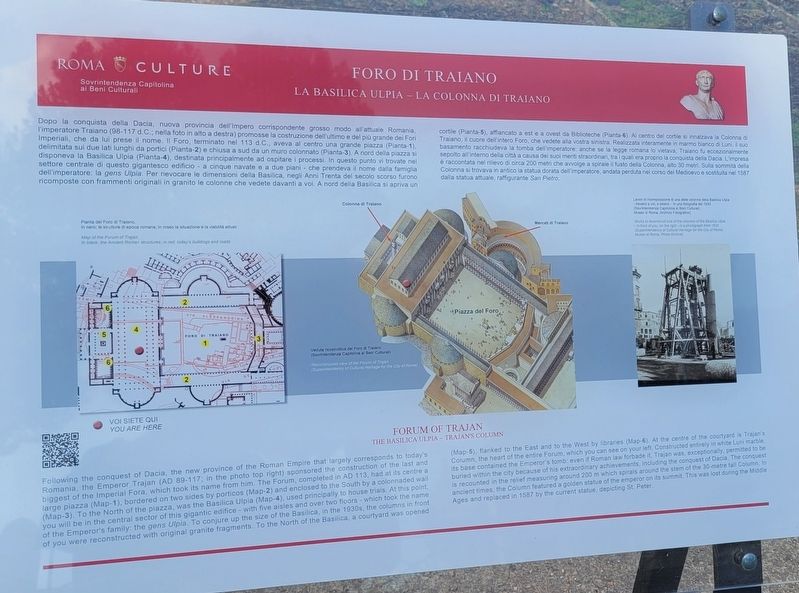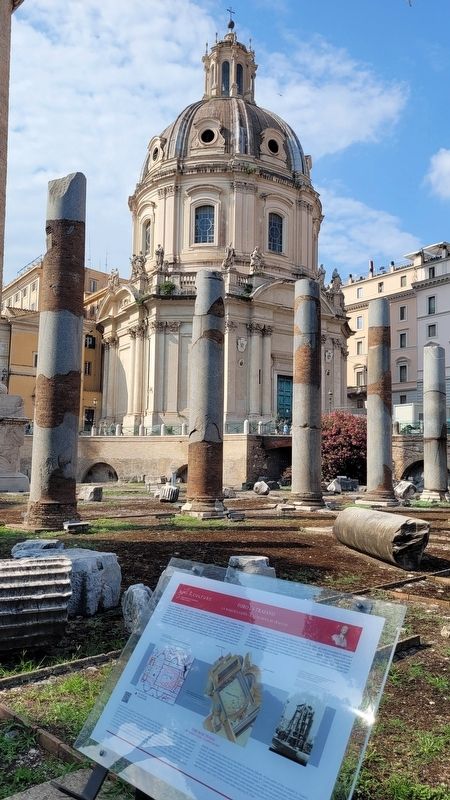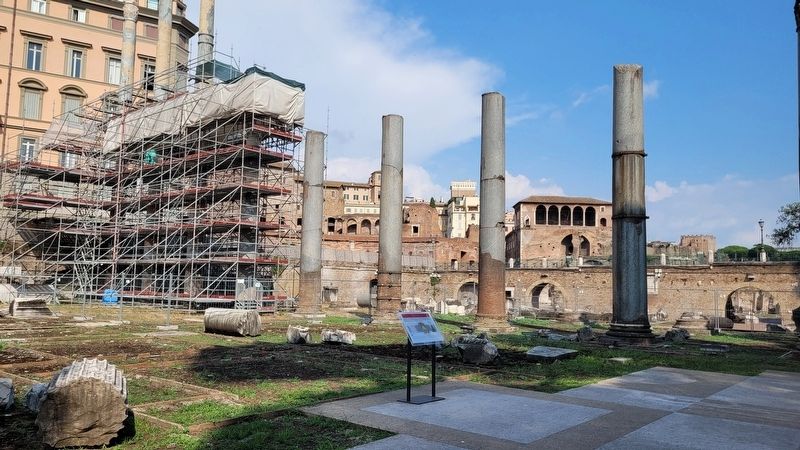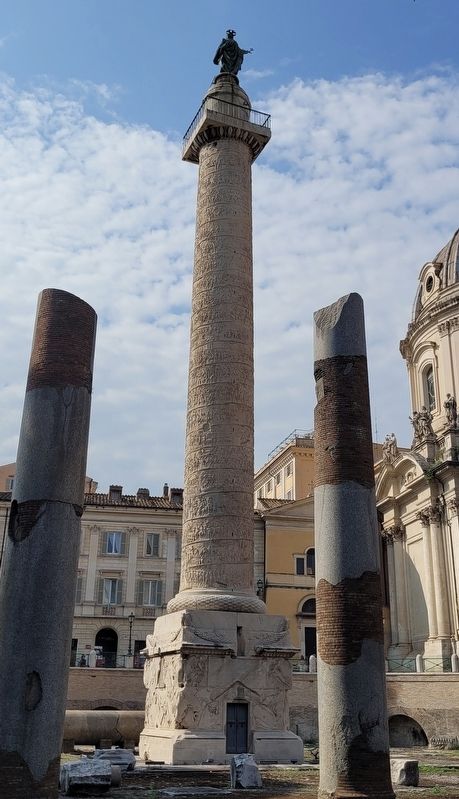Monti in Roma in Città metropolitana di Roma Capitale, Latium, Rome, Italy — Central Italy (Tyrrhenian Coast)
Foro di Traiano / Forum of Trajan
La Basilica Ulpia - La Colonna di Traiano / The Basilica Ulpia - Trajan's Column
Didascalie
Sinistra: Pianta del Foro di Traiano. In nero: le strutture di epoca romana; in rosso la situazione e la viabilità attuali.
Centro: Veduta ricostruttiva del Foro di Traiano (Sovrintendenza Capitolina al Beni Culturali)
Destro: Lavori di ricomposizione di una delle colonne della Basilica Ulpia -davanti a voi, a destra - in una fotografia del 1933 (Sovrintendenza Capitolina al Beni Culturali; Museo di Roma, Archivio Fotografico)
Following the conquest of Dacia, the new province of the Roman Empire that largely corresponds to today's Romania, the Emperor Trajan (AD 89-117; in the photo top right) sponsored the construction of the last and biggest of the Imperial Fora, which took its
name from him. The Forum, completed in AD 113, had at its centre a large piazza (Map-1), bordered on two sides by porticos (Map-2) and enclosed to the South by a colonnaded wall (Map-3). To the North of the piazza, was the Basilica Ulpia (Map-4), used principally to house trials. At this point, you will be in the central sector of this gigantic edifice - with five aisles and over two floors - which took the name of the Emperor's family: the gens Ulpia. To conjure up the size of the Basilica, in the 1930s, the columns in front of you were reconstructed with original granite fragments. To the North of the Basilica, a courtyard was opened (Map-5), flanked to the East and to the West by libraries (Map-6). At the centre of the courtyard is Trajan's Column, the heart of the entire Forum, which you can see on your left. Constructed entirely in white Luni marble, its base contained the Emperor's tomb: even if Roman law forbade it, Trajan was, exceptionally, permitted to be buried within the city because of his extraordinary achievements, including the conquest of Dacia. The conquest is recounted in the relief measuring around 200 m which spirals around the stem of the 30-metre tall Column. In ancient times, the Column featured a golden statue of the emperor on its summit. This was lost during the Middle Ages and replaced in 1587 by the current statue, depicting St. Peter.
Captions
Left: Map of the Forum of Trajan. In black: the Ancient Roman structures; in red: today's buildings and roads.
Center: Reconstructed view of the Forum of Trajan (Superintendency of Cultural Heritage for the City of Rome)
Right: Works to reconstruct one of the columns of the Basilica Ulpia -in front of you, on the right-in a photograph from 1933 (Superintendency of Cultural Heritage for the City of Rome, Museo di Roma, Photo Archive)
Erected by Roma Culture and Sovrintendenza Capitolina ai Beni Culturali.
Topics. This historical marker is listed in these topic lists: Anthropology & Archaeology • Architecture. A significant historical year for this entry is 1587.
Location. 41° 53.728′ N, 12° 29.067′ E. Marker is in Roma, Lazio (Latium, Rome), in Città metropolitana di Roma Capitale. It is in Monti. Marker is on Via dei Fori Imperiali, 0.1 kilometers north of Via Alessandrina. The marker is located along the pathway in the Foro Traiano and south of Trajan's Column. Touch for map. Marker is in this post office area: Roma, Lazio 00187, Italy. Touch for directions.
Other nearby markers. At least 8 other markers are within walking distance of this marker. Foro di Traiano (112-113 d.C.) / Forum of Trajan (112-113 A.D.) (within shouting distance of this marker); Palazzo Valentini (within shouting distance of this marker); Auditoria di Adriano / Hadrian's Auditoria (about 90 meters away, measured in a direct line); Chiesa di Santa Maria di Loreto / Church of Santa Maria of Loreto (about 90 meters away); Strutture Medievali e Moderne (XII-XX Secolo) / Medieval and Modern Structures (12th-20th Century) (about 90 meters away); Vittoriano (about 90 meters away); Italian government officially recognized Czech-Slovakia (about 120 meters away); Michelangelo’s House (about 120 meters away). Touch for a list and map of all markers in Roma.
More about this marker. The marker is located in the Parco Archeologico del Colosseo (Roman Forum Archaeological Park) and it does require an entry fee to visit.
Also see . . .
1. Il Foro di Traiano. Roma Sovrintendenza Capitolina ai Beni Culturali (Submitted on November 26, 2023, by James Hulse of Medina, Texas.)
2. Trajan's Column. Wikipedia
Trajan's Column (Italian: Colonna Traiana, Latin: Columna Traiani) is a Roman triumphal column in Rome, Italy, that commemorates Roman emperor Trajan's victory in the Dacian Wars. It was probably constructed under the supervision of the architect Apollodorus of Damascus at the order of the Roman Senate. It is located in Trajan's Forum, north of the Roman Forum. Completed in AD 113, the freestanding column is most famous for its spiral bas relief, which depicts the wars between the Romans and Dacians (101–102 and 105–106). Its design has inspired numerous victory columns, both ancient and modern.(Submitted on November 26, 2023, by James Hulse of Medina, Texas.)
Credits. This page was last revised on November 26, 2023. It was originally submitted on November 25, 2023, by James Hulse of Medina, Texas. This page has been viewed 36 times since then and 9 times this year. Photos: 1, 2, 3, 4. submitted on November 26, 2023, by James Hulse of Medina, Texas.



